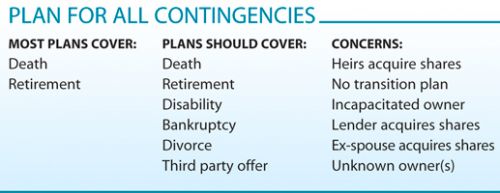Avoid the Top 10 Mistakes in Business Continuation Planning

Only about a third of privately-held family businesses ever make it to the second generation. There are many reasons for this. One of the most important is a failure on the part of the business owner to develop a plan to cover all of the possible risks when he or she dies, retires or is otherwise removed from the scene. Here are 10 common mistakes that can derail even the most profitable company:
1. Failure to develop a plan. This seems obvious, but it bears repeating: Putting off planning is a serious mistake. Nothing will happen until fears are pushed aside and the owner or owners begin the difficult work of considering what happens to the business when they are gone.
2. Choosing the wrong type of plan. A buy-sell agreement is the linchpin of succession planning. A number of factors go into determining the best type of buy-sell arrangement, including the type of business structure and number of owners. There are two primary forms of business continuation plans:
- Redemption Plan. Often used when the company has more than one shareholder. The terms of the agreement generally specify that the company will redeem a shareholder’s stock when a triggering event occurs.
- Cross-Purchase Plan. The remaining business owners agree to purchase the interests of departed shareholders when a triggering event occurs. This plan can involve complex life insurance planning.
In a redemption plan, remaining shareholders have increased ownership percentages but no change in their tax basis in the business. By contrast, remaining shareholders in a cross-purchase plan have both increased ownership and increased tax basis. Substantial amounts of capital can be lost to taxes as a result of improper buy-sell plan selection.
3. Not planning for all contingencies. Death and retirement are the two most common triggering events, but there are others that should not be overlooked. Each creates its own concerns and should be addressed in a comprehensive plan.
4. Inappropriate valuation method. The best way to assure that you have an accurate business valuation is to involve a valuation expert. An improper value has consequences throughout the plan. There are three basic valuation methods:
- Asset Based. Value is based on the fair market value of the company’s assets, less its liabilities. Used when no goodwill/blue sky is present in the company.
- Income Based. Appropriate for operating entities; focuses on historical and future earnings.
- Market Based. Probably the most misused approach by casual valuators, it is appropriate for larger operating entities.
5. Not considering key value drivers. There are no boilerplate answers when it comes to valuation. For a valuation to truly represent the company, it must consider many unique factors, including earnings, growth, customer relationships, risk, discounts and levels of ownership. The early involvement of a business valuation expert is the key to getting it right.
6. Not using different levels of ownership for intra-family transfers. All shareholders are not created equal, and that gives business owners flexibility to transfer ownership to family members over a specified time period without actually relinquishing control of the company. There are three levels of ownership:
- Control Value. Over 50% of voting shares; may require a small marketability discount
- Blocking. 50/50; is non-controlling, so will have discount for lack of control and lack of marketability, though smaller discounts than straight minority ownership
- Minority. Less than 50% voting or any non/voting/limited partner block; full discounts for lack of control and lack of marketability.
The goal in gifting is to move the stock at the lowest “tax value” possible, which would include minority blocks of voting shares, and blocks of non-voting shares.
7. Creating red flags for the IRS. Many business transition agreements set a fixed value for transfers, with the intent of minimizing transfer costs and avoiding gift taxes. In the end, this may not reflect the “fair market value” that is required by the IRS, resulting in unexpected tax consequences. Get a formal appraisal by a qualified appraiser to support the transaction price, especially for transfers between related parties.
8. Not acting to retain key employees. Key employees who are not owners will be concerned with the death or departure of the owner. Depending on the person and the position, retention strategies may be instituted, including non-qualified deferred compensation plans, stay bonuses, long-term incentives, stock ownership plans and phantom stock plans. Some strategies, such as non-qualified deferred compensation plans, may create liabilities that reduce fair market value. Be sure to explore all of the valuation and tax consequences.
9. Failing to finance the plan. Continuation plans often fail because there is not enough personal capital or capital within the company to complete the agreement between remaining shareholders. A common strategy to make sure that cash is available is to purchase life and/or disability insurance policies on the owner(s). Whether the business owners choose to “self-insure” the risk or transfer it to an insurance company, it is critical that assets be available to complete the purchase when an owner leaves the business.
10. Not updating the plan. People change, personal situations change, relationships change. A business continuation plan should be flexible enough to accommodate all of the changes in the lives of the business owner(s). Key documents, insurance policies and other funding strategies should be reviewed at least every two years. iBi
Joe Glawe, CPA/ABV, ASA, is a partner in Clifton Gunderson’s Peoria office. He has more than more than 30 years of experience and specializes in taxation, business valuation and litigation support.

